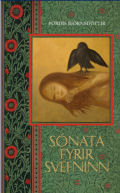Nighttime Sonata
"My grandfather earnestly believed that while he slept, he would be transported inside other people, and that his dreams were the experiences of the other person.” These nomadic dreamings inspired Þórdís Björnsdóttir to write her second novel.
One long dream
“My grandfather earnestly believed that while he slept, he would be transported inside other people, and that his dreams were the experiences of the other person. As for myself, I believe he was right,” says author Þórdís Björnsdóttir in an interview with Sagenhaftes Island. The nomadic dreamings of her grandfather provided the inspiration for Sónata fyrir svefninn / Nighttime Sonata, a novel published by Bjartur last year.
“In a way, Nighttime Sonata is like one long dream, in which I'm mulling over what reality is, and what kind of reality is authentic,” says Björnsdóttir. “For instance, I once met a man who had taken the hallucinogen mescaline while travelling through South America. While under its influence, he transformed into a fish. He told me he could feel the fins and the tail. He began to open and close his mouth like a fish as he swam along. To which I say: was he or was he not a fish? That's a big question.”
Elastic reality
 A young woman by the name of Ivana arrives at a strange town, searching for a missing man who seems to have the ability to travel outside his body. Moving into an apartment in town, Ivana encounters a series of characters who sometimes seem to be of another world. Reality is an elastic term in this second novel of Björnsdóttir, and soon enough, the boundaries between dream and reality completely evaporate: Ivana's basement contains a tunnel leading to a world unbound by the laws of our own, and her neighbour, the pianist Garibaldi, turns out to be the author of the story. Ivana's search is permeated with a sense of foreboding and dread, and death is never far off.
A young woman by the name of Ivana arrives at a strange town, searching for a missing man who seems to have the ability to travel outside his body. Moving into an apartment in town, Ivana encounters a series of characters who sometimes seem to be of another world. Reality is an elastic term in this second novel of Björnsdóttir, and soon enough, the boundaries between dream and reality completely evaporate: Ivana's basement contains a tunnel leading to a world unbound by the laws of our own, and her neighbour, the pianist Garibaldi, turns out to be the author of the story. Ivana's search is permeated with a sense of foreboding and dread, and death is never far off.
Reviewing the novel, critic Úlfhildur Dagsdóttir compared Nighttime Sonata to a David Lynch film, and also pointed out parallels with such luminaries as Kristín Ómarsdóttir and Gyrðir Elíasson. “This beautiful little book is well worth reading – again and again,” she went on to say. Una Sighvatsdóttir of Morgunblaðið was similarly impressed: “Björnsdóttir succeeds superbly in leading the reader on, building tension by straying back and forth in time, slowly doling out tidbits of information. She tells an interesting story, beset by symbols and omens. The meanings of these, however, are for the reader to deduce.” Ágúst Borgþór Sveinsson in turn called the work a elegant, restrained and exquisitely chiselled work of fantasy: “An exciting flight of fancy […] The story is written with a deep sensibility for the human condition: the need to be at one with other people, and the obstacles on the way to that goal […] The story is concise and carefully structured. When coupled with the work's intoxicating style, the outcome is bound to be superb. Þórdís Björnsdóttir is an accomplished author, and an exciting one.”
Everyday macabre
 Björnsdóttir published her debut novel, Saga af bláu sumri / Story of a Blue Summer, in 2007. By then, however, she was already a well-known poet. She claims that the transition to prose was an easy one – almost automatic.
Björnsdóttir published her debut novel, Saga af bláu sumri / Story of a Blue Summer, in 2007. By then, however, she was already a well-known poet. She claims that the transition to prose was an easy one – almost automatic.
I never sit down and decide to write a novel or a book of poetry. The ideas just come to me, demanding that I work them into definite form. When I have an idea for a novel, I know right away that it's a story and not a poem. From then on, my job is to bring it out into the world for others to enjoy. Poems come to me in a different way. They usually arrive one by one – sometimes over a period of months or even years. So collecting material for that kind of book often takes a long time. By contrast, when I'm writing a novel, I have a good idea of where I'm going, and may even complete the first draft in one go. The writing process is pretty different, depending on whether it's a novel or a poetry book.
Björnsdóttir's work, with its heady cocktail of horror and mystique, has previously been likened to the gothic tradition. Like her other works, Sonata is characterized by a low-key dread, stirring beneath the surface of the story and prepared in Björnsdóttir's “cosily creepy fashion” as Úlfhildur Dagsdóttir put it. When asked where this interest in the macabre comes from, Björnsdóttir answers that years of being afraid of the dark have left her not only capable of imagining all kinds of grotesqueness, but also deeply fascinated with the discomfort these fantasies provoke in her.
“I think these tendencies act strongly on me as I write, sometimes consciously and sometimes not. I find it thrilling to feel a sense of looming threat, even if that threat is imaginary. The more mundane the circumstances in question the better, because that adds a dimension of humor to the connection, which I like. In my day-to-day life, I conjure up all kinds of bizarre images in my mind, because I find it important to imbue everyday existence with a sense of the fantastic. That way, it isn't just about sitting down to write and then standing up to do something else – creativity and day-to-day life are combined. That matters a great deal to me.
At the moment, Björnsdóttir has two novels and three books of poetry in the works. “These days I'm concentrating on one of the novels. I'm going into self-imposed exile in Stykkishólmur around the beginning of August, and I'll spend the next two months there. I'm hoping to finish most of the book during the stay.”
